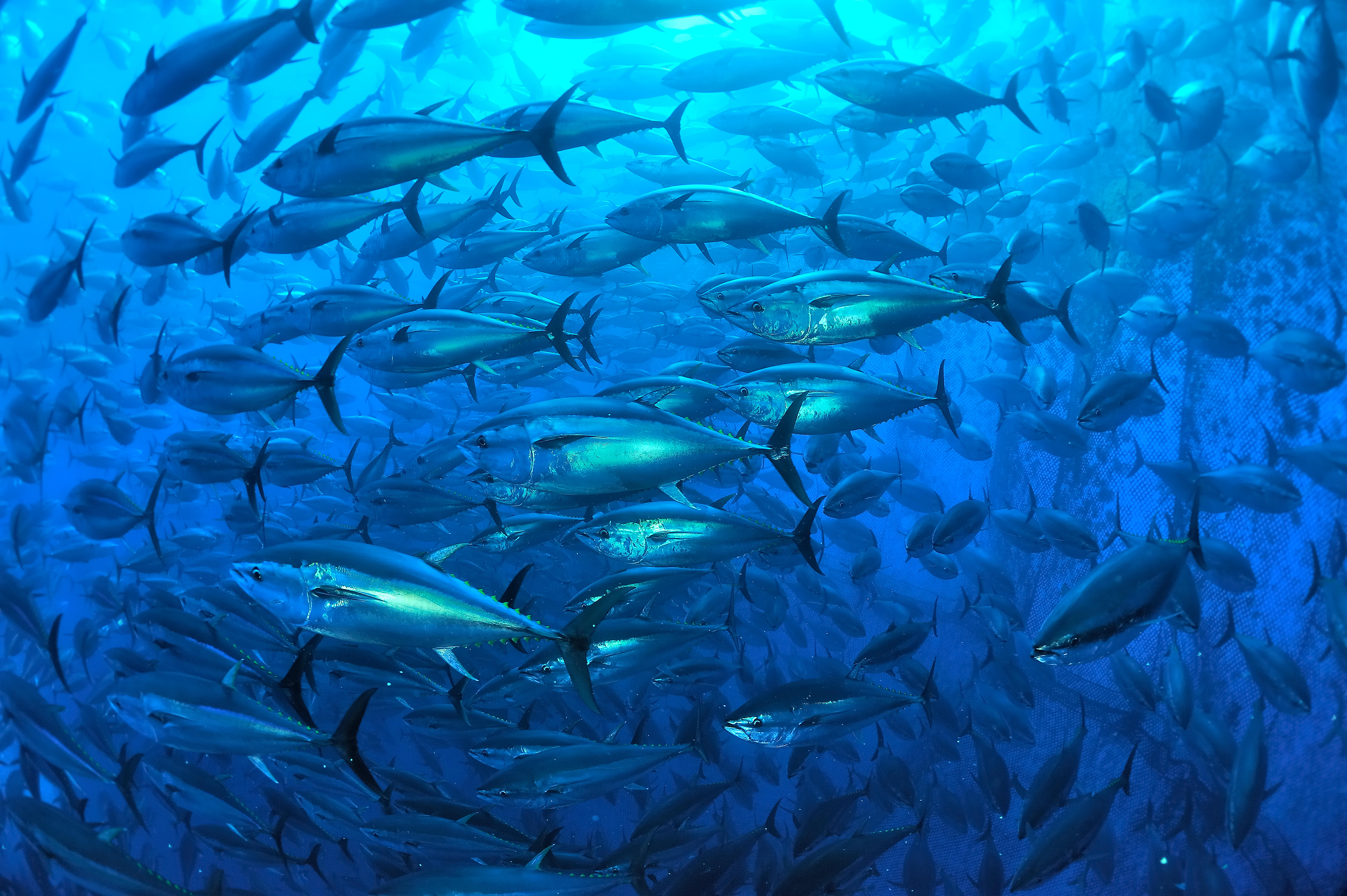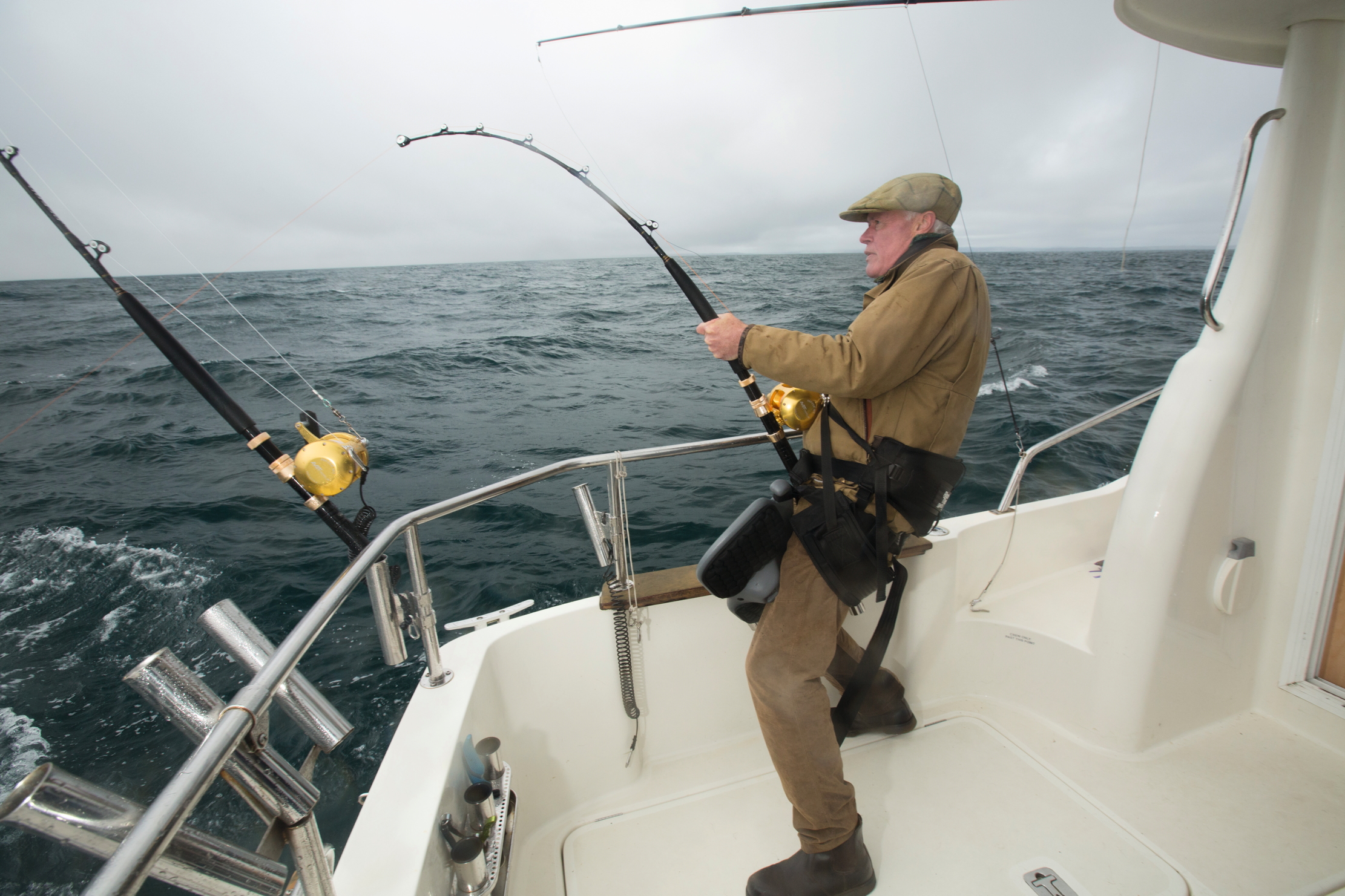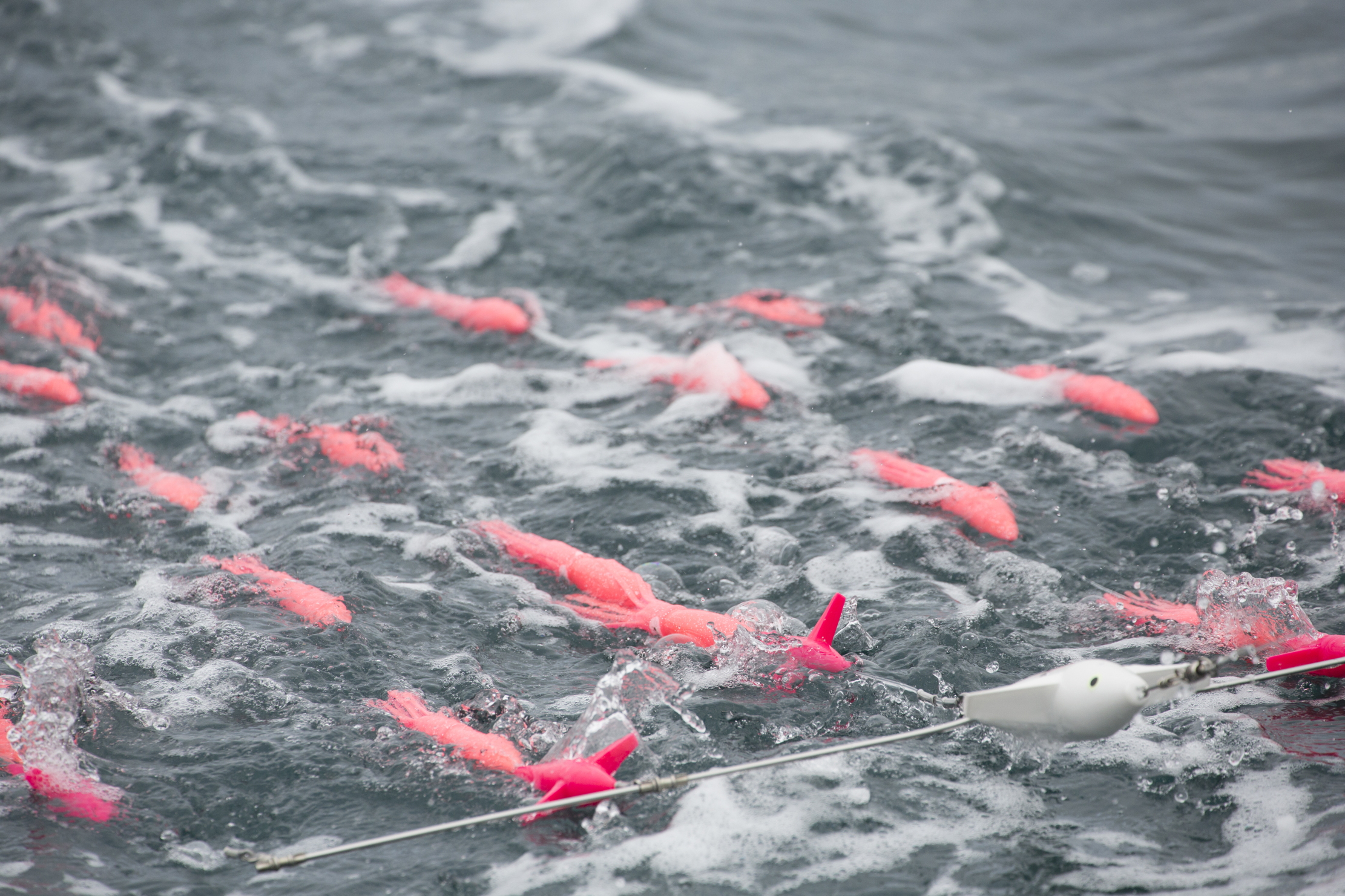'We don’t expect to catch monsters in British seas': The return of the bluefin tuna
It’s no longer necessary to venture to tropical waters in order to catch a monster tuna, says Jonathan Young, as he attempts to land a big-game fish in Falmouth Bay.

'Nine o’clock, 200 yards!’ yells the lookout on the flying bridge. They were there, a maelstrom of bluefin tuna crashing into baitfish, scimitar tails scything the water, every fish more than 100lb.
It was all slightly unreal. Apart from conger eels, common skate and some shark species, we don’t expect to catch monsters in British seas. Big-game fishing is associated with warm waters, Hawaiian shirts, Bermuda shorts and a rum-punch sundowner. Yet, here were scores of tuna in Falmouth Bay, Cornwall, on a grey October day.
We were aboard Sailfish, a 34ft specialist big-game boat owned and skippered by Peter Hyde and crewed by Mark Gibbens and Pip Earl. When ashore, Hyde grows Christmas trees, Gibbens has a country-side management company and Earl is a builder in London, following a stint as a Life Guards officer. Afloat, they are hardcore tuna men, bonded by a passion for the fish and the fishing.
'Some days you’ll spot tuna “busting” the sea’s surface as far as the eye can see'

‘I started doing it commercially in April 2024,’ reveals Hyde, above the purr of the twin 260hp Volvo engines as we leave Mylor harbour. ‘It’s such an amazing fishery. Some days you’ll spot tuna “busting” the sea’s surface as far as the eye can see. We average three a day, although sometimes we catch tons, from 100lb–700lb.’ Bigger fish are out there: in 2022, a 900lb leviathan was caught off the Pembrokeshire coast.
Such fish have not been seen since the days of the old British Tunny Club, which operated out of Scarborough, North Yorkshire, in the 1930s until it came to an end with the collapse of the herring stocks. The last huzzah took place on August 25, 1950, when H. E. Weatherley, a prolific club member, landed four bluefin tuna of 589lb, 545lb, 743lb and 714lb — all before breakfast.
Why are the tuna back? That question is being addressed by Thunnus UK, a collaborative research project between the University of Exeter, the Centre for Environment, Fisheries and Aquaculture Science (Cefas) and the Tuna Research and Conservation Centre of Stanford University (TRCC) in California, US. Marine scientist Matthew Witt, who works on the project at the University of Exeter, says the factors include ‘increases in catch control, leading to increases in abundance (arising from breeding); improved environmental conditions for survivorship of fish at younger life stages; and availability of prey or food’.
‘Warming seas may also mean smaller individuals can now reach UK waters, but we caution against saying “climate change” is the reason,’ he continues. ‘Bluefin were once part of UK fauna until the 1950s, then numbers started to decline, but now they are increasing. Fish populations can also respond to large-scale climatic phenomena that have oscillatory periods of decades.’
Exquisite houses, the beauty of Nature, and how to get the most from your life, straight to your inbox.
As to how many tuna are now swimming off British and Irish coastal waters, Dr Witt says sightings started being reported frequently in the 2010s, but that there are ‘no robust population estimates of fish occupying UK waters’. To help provide the researchers with data, fishermen have been recruited as citizen scientists through the Atlantic Bluefin Tuna Catch and Release Tagging programme (CHART) run by Cefas. In 2022, 25 recreational fishing charter boats tagged 1,090 tuna. The 8in satellite tags are attached externally and record ambient light, temperature and depth every 15 seconds then, on a set date, detach themselves from the tuna and transmit the data to a satellite network.
The CHART programme also revealed that recreational tuna fishermen created £2.6 million and 34 full-time jobs for the local economy. As a result, there is now a split-fishery in the UK, which currently has a quota of 66 tons — 16 for recreational catch-and-release fishing, 39 for commercial fishing and the remainder allocated to commercial bycatch and tagging programmes.
Hyde’s boat is part of the recreational catch-and-release fleet, but how do you release, unharmed, a huge tuna? ‘First you have to catch them,’ he reveals, pulling out ‘the spreader’ — a string of bright pink rubber lures. ‘They’re a bit like a squid football team,’ continues Gibbens. ‘At the front you have the “bird”, which works like a paravane, keeping the whole rig on the surface and also causing some disturbance. Then come the squids, in a series of rows and finally, at the end, is the “stinger” — either another rubber squid lure or a whole mackerel, but each armed with a size 10/0 hook.’ Four sets are attached to the rods and lowered over the side, with two mounted on outriggers on each side of the boat and towed at 4.5mph.
‘The rods are always clipped onto the boat or the fisherman,’ adds Hyde. ‘Those are 80-class Penn rods and 50-class Avet reels spooled with 656 yards of hollow braid, ending in 109 yards of 130lb breaking-strain monofilament. All of which means that if one goes over the side, that’s £1,000 gone.
‘Once they’re all out there, they cause a helluva water disturbance and vibration and the tuna come up, see the last “fish” — the stinger — apparently trying to catch up with the shoal and grab it. Often you see the take and it’s spectacular. Then the fun begins,’ he says with a smile. With that, we steam through Falmouth Bay, eyes scanning for ‘busts’ of tuna breaking surface or birds.
‘For me, much of the thrill of tuna fishing is all the other wildlife you see,’ observes Gibbens. ‘The birds are the key to the tuna and utterly fascinating in their own right. The Manx shearwaters are the most numerous and they follow the tuna, waiting to pick up scraps. Very often, even if no fish are breaking the surface, birds sitting on the water will result in “blind strikes” on the stingers. The only problem with the shearwaters is that they are fairly inconspicuous at distance — gulls and gannets are far easier to spot. However, teenage gannets aren’t very reliable!’
'You don’t play tuna from a fighting-chair, you take them on standing, which is ‘amusing’ on a boat rolling in a heavy swell'

The 'spreader' in the water. Otherwise known as 'the squid football team'.
As if on cue, Sailfish changes course by a few degrees and we see the slate sky flecked with birds. ‘Let’s go fishing,’ calls Hyde, prompting the crew to set the spreaders and to start trussing me up in a back-brace and a Black Magic rod-holder, a sort of cod-piece (or should that be ‘tuna-piece’?). You don’t play tuna from a fighting-chair, you take them on standing, which is ‘amusing’ on a boat rolling in a heavy swell.
‘Bust!’ calls Earl and seconds later the port outrigger rod bows over. In the next 30 seconds the remaining three spreaders are winched in, the rod thrust into my Black Magic and there it was: something very strong, heavy and annoyed, heading into the depths.
A multiplier reel is so named because one turn of the handle will revolve the spool, say, six or seven times. However, the handle would not turn. Line kept running off the reel. Finally, the fish stopped and, using my feet and backfire leverage, I managed to scrape a few feet back onto the reel. Then the boat moved forwards and the hard-won line went out again. I retrieved some, but the fish woke up, plummeted down and took more out. And so it went on. And on.
Yet, inch by inch, the braid was retrieved and replaced by the clear monofilament. The tuna, now below the stern, gave an occasional silvery-green flash, doggedly swimming in tight circles. Yet, it was growing larger as I kept leaning back on the rod and gaining line until the flash took tuna form as it was forced to the surface.
Fish aren’t gaffed or boated on catch-and-release boats. The plan is to haul them alongside as quickly as possible, so they can recover easily and hold them with a ‘lip grip’ on an extended handle. They’re held there as oxygenated water floods their gills, then they swim off and you give them a cheery wave. To achieve this, once the fish has surfaced, one crew member grabs the trace below the swivel as the other operates the lip-grip. The fish came up, the trace was grabbed, but the fish gave a violent splash and was gone. Gone. Bloody gone.
There’s a school of thought that runs thus: once you’ve brought the fish alongside and a hand has grabbed the line below the swivel, it’s ‘caught’. Had we been using a gaff, it would have been, but we weren’t and it wasn’t. It escaped. As did another, three hours later, that threw the hook within 32ft of the boat.
Those two fish are now in the Channel, the Atlantic or the Mediterranean — and good luck to them. However, this August, if they are in Falmouth Bay, I intend to meet them and their cousins.
A day aboard ‘Sailfish’ with Peter Hyde costs £1,200 for the whole boat. For more details click here
Jonathan Young is a freelance journalist. He previously edited The Field and Shooting Times.
-
 'Good news, let’s make the £20 million deal happen': The Mansion Tax that turned out to be 'the least worst outcome for prime property', and the places that will be hit
'Good news, let’s make the £20 million deal happen': The Mansion Tax that turned out to be 'the least worst outcome for prime property', and the places that will be hitWhere in Britain are the £2 million homes set to be hit by the Mansion Tax? Anna White takes a look.
-
 A very taxing quiz indeed: Country Life Quiz of the Day, November 26, 2025
A very taxing quiz indeed: Country Life Quiz of the Day, November 26, 2025Test your general knowledge in today's Quiz of the Day.
-
 Aristotle believed they emerged spontaneously from mud, Sigmund Freud dissected thousands of them and they can dive lower than a nuclear submarine — but what is the truth about the eel?
Aristotle believed they emerged spontaneously from mud, Sigmund Freud dissected thousands of them and they can dive lower than a nuclear submarine — but what is the truth about the eel?It would seem the European eel has a long way to go to win hearts, Laura Parker says of the slippery animal with an unfortunate image problem.
-
 The Alpine rescue dog built for blizzards, bred by monks
The Alpine rescue dog built for blizzards, bred by monksAs snow fell across the UK this week, I found myself day-dreaming of St Bernards striding through the Alps — a snow-day dog worth celebrating.
-
 Better than Ozempic? 50 years of the Brompton bicycle
Better than Ozempic? 50 years of the Brompton bicycleOwen Wilson, James May and most of the middle-aged men and condescending hipsters you know love them. As the iconic folding bike turns 50 Lotte Brundle hops on one with the company's CEO.
-
 No more froths, no more foams, no more tweezers. Classic dining is making a comeback. Thank god
No more froths, no more foams, no more tweezers. Classic dining is making a comeback. Thank godFrom prawn cocktail and Arctic roll to starched tablecloths and ‘nicotine cream’ on the walls, it’s out with the new and in with the old in the restaurant world
-
 'It is hard to beat the excitement of watching a peregrine you have trained stoop from 1,000ft, going more than 100mph' — the complicated world of falconry
'It is hard to beat the excitement of watching a peregrine you have trained stoop from 1,000ft, going more than 100mph' — the complicated world of falconryA combination of spellbinding sport and profound empathetic connection, falconry–a partnership in which the bird maintains the upper hand–offers a window into ‘the deeper magic’.
-
 What is everyone talking about this week: More than half the country owns a pet and nearly half our marriages end in divorce — no wonder pet-nups are on the rise
What is everyone talking about this week: More than half the country owns a pet and nearly half our marriages end in divorce — no wonder pet-nups are on the risePet-nups, a formal agreement between couples over what should happen to their pets in the event of a split, are on the rise.
-
 How fashions finest would dress an Airedale, Dalmatian, corgi and more if only they had the chance
How fashions finest would dress an Airedale, Dalmatian, corgi and more if only they had the chanceWe’ve matched some much-loved breeds to the designers that share their history, temperament and vibe — because why not. Illustrations by Tug Rice.
-
 Baby, it’s cold outside (even if you have a natural fur coat): How our animals brave the winter chill
Baby, it’s cold outside (even if you have a natural fur coat): How our animals brave the winter chillWhen the temperature drops, how do Britain’s birds, beasts and plants keep the cold at bay? John Lewis-Stempel reveals Nature’s own thermals.